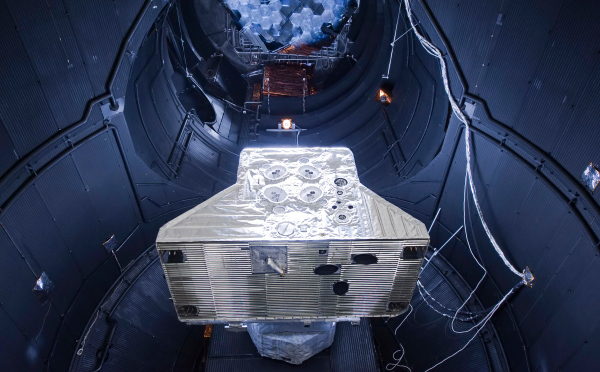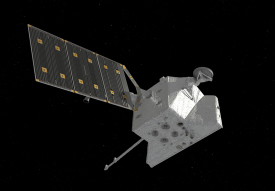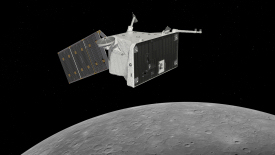Mercury Planetary Orbiter - spacecraft
The Mercury Planetary Orbiter (MPO) is ESA's scientific contribution to the mission. The Institute of Space and Astronautical Science (ISAS) at the Japan Aerospace Exploration Agency (JAXA) has provided the other science spacecraft, the Mercury Magnetospheric Orbiter (Mio). ESA has also built the Mercury Transfer Module (MTM), which carries the two orbiters to their destination, and the Magnetospheric Orbiter Sunshield and Interface Structure (MOSIF), which provides thermal protection and the mechanical and electrical interfaces for Mio. The Mercury Composite Spacecraft (MCS) consists of the MPO, Mio, MTM and MOSIF. ESA is responsible for the overall mission design, the design, development and test of the MPO, MTM and MOSIF, the integration and test of the MCS and the launch.
Mechanical and thermal design
The MPO design is optimised to meet the needs of the payload when the spacecraft is in its operational orbit. The payload components are mounted on the nadir side of the spacecraft, with certain instruments or sensors located directly at the main radiator, to achieve low detector temperatures. The MERTIS and PHEBUS instruments are located at the radiator to provide their calibration field of view and rotational field of view, respectively. The SIMBIO-SYS sensors and the BELA optical head are located on a highly stable optical bench with the star trackers and gyroscopes, to provide the required pointing performance. The ISA is located fairly close to the centre of mass – this location is compatible with the ISA requirements. The MERMAG sensor is mounted on a 3.2-metre deployable boom, providing it with a suitably low magnetic background.
 |
| The Structural and Thermal Model of the MPO in the Large Space Simulator at ESTEC. Credit: ESA/Anneke Le Floc'h |
The spacecraft structure uses a double-H configuration, designed to harmonise with the single radiator plane necessitated by the Mercury orbit. Heat generated by spacecraft subsystems and payload components, as well as heat that is coming from the Sun and Mercury as it "leaks" through the blankets into the spacecraft, is carried to the radiator by panel-embedded heat pipes. The structural design provided free access to all equipment and instruments during the Assembly, Integration and Test (AIT) programme. The design is mass efficient, with the primary structure serving as the mounting surface for all equipment; it was able to remain permanently assembled during AIT, avoiding the need for connector brackets and preventing alignment disturbances. MPO has four-point bolted interfaces to both the Mercury Transfer Module (MTM) and the Magnetospheric Orbiter Sunshield and Interface Structure (MOSIF), which provides thermal protection and the mechanical and electrical interfaces for Mio during the journey to Mercury.
The configuration and thermal design provide a classical thermal environment for internally mounted instrument equipment – avoiding costly development programmes by re-use of available hardware – while employing dedicated high temperature technologies for external items such as antennas, the solar array, the sun sensors and Multi-Layer Insulation (MLI), which are exposed to the harsh thermal environment around Mercury.
Power generation
 |
| Artist's impression of the MPO spacecraft. Credit: ESA/ATG medialab |
The solar array is a single-sided design, which uses Optical Solar Reflectors (OSRs) for temperature control. The solar array requires continuous rotation, keeping the Sun at a low incidence angle in order to generate adequate power while at the same time limiting the temperature. The three-panel array has its rotation axis in an optimised direction, which places the occurrence of the so-called "artificial eclipses" (a condition in which the Sun vector is along the rotational axis of the solar array, i.e. no power is available) at acceptable times during the Mercury year. The solar array will provide up to 1000 W of electrical power during full science operations phases. During both the natural and artificial eclipses the battery in the MPO will provide electrical energy to the spacecraft in order to allow the scientific operations to continue without interruption.
Communications
The MPO is equipped with two fixed Low-Gain Antennas (LGAs), a steerable Medium-Gain Antenna (MGA) and a steerable one-metre-diameter High-Gain Antenna (HGA). The two X-band LGAs provide omnidirectional coverage at small distances from Earth and can also be used for emergency commanding at any distance. The X-Band MGA is used primarily during the interplanetary cruise phase and can also be used in safe and survival modes. The HGA provides X-band uplink and downlink and Ka-band downlink communications for spacecraft and science operations. The HGA is also used during the cruise phase to enhance communications and data dump capabilities whenever needed.
ESA's Cebreros 35-metre ground station is the primary ground facility for communications during all mission phases. The ground stations at Kourou (LEOP), New Norcia (critical phases during cruise and Mercury capture), Perth (LEOP), Usuda (backup) and Uchinoura (backup) will be available for backup during critical flight phases and/or for use during special campaigns.
Attitude and orbit control system
The principal Attitude and Orbit Control System (AOCS) equipment consists of:
- three Star Trackers (STRs), each comprising a star tracker unit housing the optics and electronics, a shutter – which can be closed in the event of a major attitude control anomaly – and a baffle;
- two Inertial Measurement Units (IMU), including four high-accuracy rate-integrating gyros and four accelerometers in a tetrahedral configuration, together with the processing electronics;
- two redundant sets of two Fine Sun sensors;
- four reaction wheel assemblies, controlled by two sets of wheel drive electronics;
- two redundant sets of four 22-Newton hydrazine / MON-3 (Mixed Oxides of Nitrogen, a mixture of nitrogen tetroxide and three per cent nitric oxide) thrusters to provide the change in velocity (ΔV) needed for orbit capture and orbit lowering to Mio's and the MPO's operational orbits;
- two redundant sets of four 10-Newton monopropellant (hydrazine) thrusters for attitude control and reaction wheel momentum off-loading.
The reaction wheels are mounted in a tetrahedral configuration; attitude control can be achieved with four wheels operating simultaneously (the nominal operational scenario) or any combination of three wheels.
During science operations, at least two STRs will be used in combination. In the event of major system anomaly on the spacecraft and consequent loss of attitude control, dedicated shutters will protect the STR optical paths to prevent damage due to accidental Sun pointing.
Launch, cruise and arrival at Mercury
For launch and the journey to Mercury, the MPO is being carried with Mio as part of the MCS.
| BepiColombo launch to Mercury. Click here for video details and downloads. Credit: ESA/ATG medialab |
During interplanetary cruise, Mio is dormant, with the exception of periodic checkouts. The MPO spacecraft commands Mio and the MTM and communicates with Earth. The MTM supplies electrical power for its passengers, as well as for its electric propulsion system.
Shortly before Mercury orbit insertion, the MTM is jettisoned from the spacecraft stack. The MPO then provides Mio with the necessary resources and services until it is delivered into its mission orbit, when control is assumed by JAXA.
The MPO will travel around Mercury in a polar orbit with a period of approximately 2.3 hours, a perihermion (periapsis) of 480 km and an apohermion (apoapsis) of 1500 km. The orbit will be coplanar with that of Mio, which will have an orbital period of around 9.3 hours.





